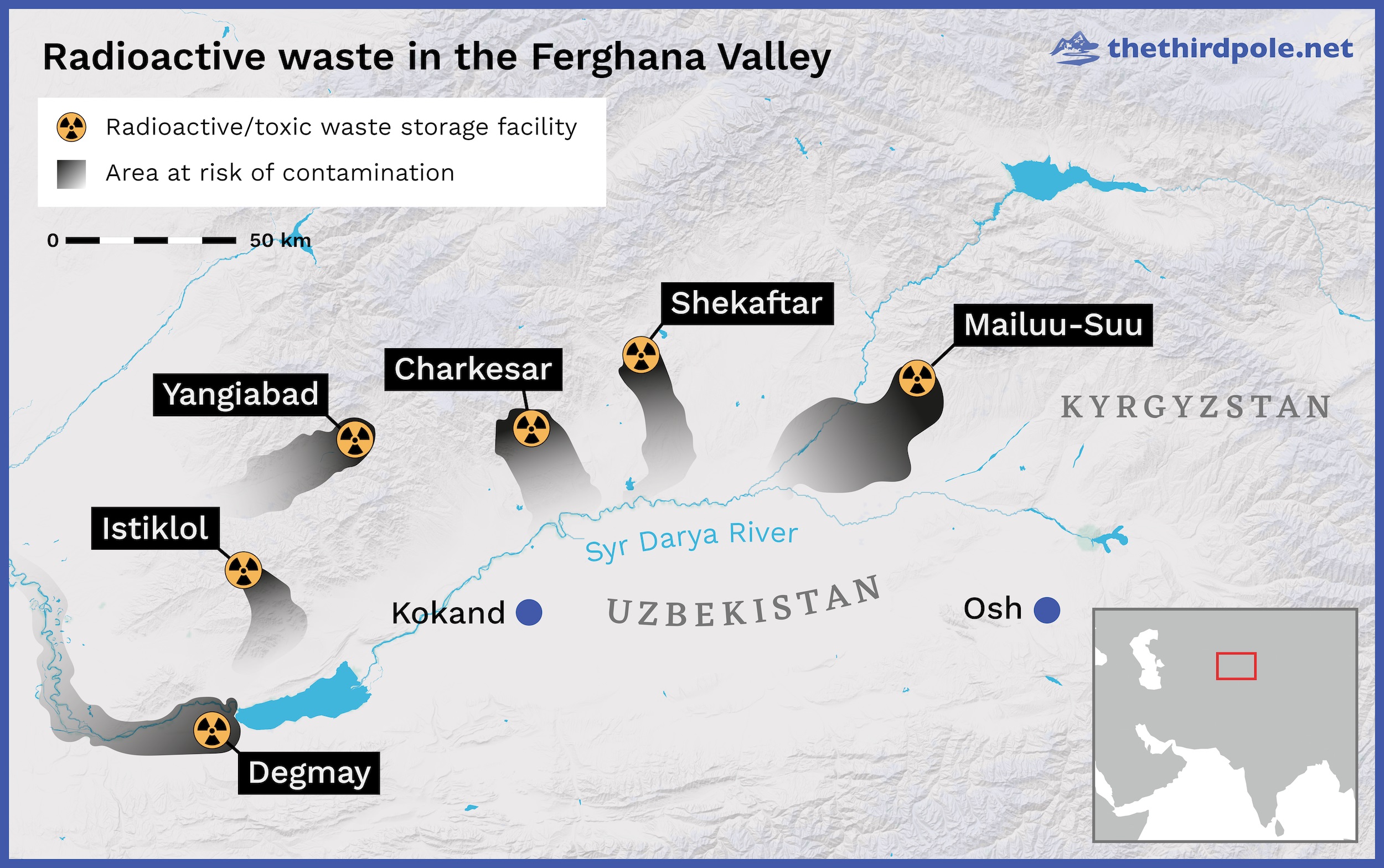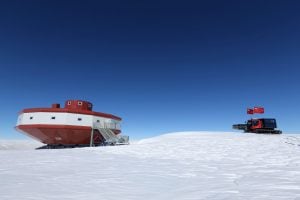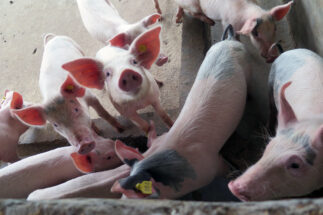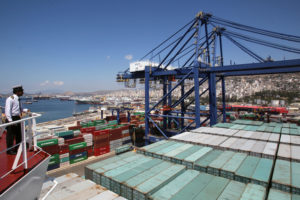Political tensions between countries in Central Asia have intensified since the collapse of the Soviet Union. Along with border conflicts and water disputes, problems have arisen from residual radioactive waste located in the Kyrgyz town of Mailuu-Suu in the Ferghana Valley, which has caused widespread pollution of river and farmland, and led to major impacts on the health and economy of people in Kyrgyzstan and Uzbekistan.
Industrial-scale uranium mining began in Mailuu-Suu during the Soviet era in 1946 and lasted until 1968. Uranium ore from Europe and China was also processed in Mailuu-Suu during this time.
As a result, the small town of 24,000 people is now surrounded by about 3 million cubic metres of uranium waste left in 23 tailings pits and 13 dumps. These sites have contaminated the Mailuu-Suu river, a major tributary of the Syr Darya which flows through Kyrgyzstan and into Uzbekistan, carrying radioactive waste into the densely populated Ferghana Valley.

The biggest problem is that earthquakes, landslides and heavy rainfall events have intensified in recent years, destroying uranium tailing storage sites along the river and mountain slopes, contaminating surrounding areas. A number of international organisations have worked to prevent further disasters in Mailuu-Suu. The World Bank has allocated more than USD 11 million to clean up uranium tailings. The European Commission launched an initiative in 2015 to remediate the most dangerous sites in Kyrgyzstan, Tajikistan and Uzbekistan.
However, the pollution remains, and Central Asian countries must cooperate to prevent further environmental disasters in the Ferghana Valley, as well as mitigate economic damage and resolve political issues.
Also see: Study confirms cancer village fears in east China
A town built on radioactive waste
According to the state surveys there are 92 radioactive and toxic storage facilities across Kyrgyzstan today. The most dangerous of these are the Mailuu-Suu uranium sites, because of numerous hazards threatening the tailing pits. Were these tailing pits destabilised, they would have potentially catastrophic environmental consequences for Kyrgyzstan and the neighbouring countries of Uzbekistan and Kazakhstan, with the radioactive waste contaminating the river as well as the soil and irrigated farmland surrounding it.
Uranium was first discovered in the region in 1933, and within 20 years 10,000 tonnes of uranium oxide was extracted in Mailuu-Suu. Residual radioactive waste in southern Kyrgyzstan currently poses a major environmental threat to the densely populated parts of the Ferghana Valley, home to about 14 million people.
Landslides are the major risk. There are more than 200 landslide-prone locations around Mailuu-Suu. There was little such threat in the 1940s, but landslide activity has intensified since 1954 due to increased rainfall. Landslides in Mailuu-Suu occurred several times in 1988, 1992 and 2002, damaging infrastructure and altering water flow. The most dangerous landslide is Koi-Tash, which happened in 2017 and could block the riverbed and spread radioactive contamination down the river.

According to Kyrgyz official data, the gamma radiation on tailings pit surfaces are within 17-60 mR/hr; however, in the damaged areas, radiation levels reach 400-500 mR/hr. An exposure to 100 mSv a year (a millisievert, mSv, is equal to 100 milliroentgens, mR) or 10,000 mR is the point where an increase in cancer is clearly evident. At 400-500 mR/hr this would be achieved in 20-25 hours, or just one day. Radionuclides and heavy metals from these tailing pits and dumps are seeping into the surface and groundwater, polluting water and farmland and increasing the risk of cancer for local people.
The Institute of Nuclear Physics under the Academy of Sciences of Uzbekistan has found that radioactive contamination in the river was two times higher during spring compared with summer, as rainfall flushes out radioactive waste from tailing pits and dumps.
Scientists at the Institute of Medical Problems, Southern Branch of the National Academy of Sciences of the Kyrgyz Republic, have been investigating the radioactive contamination in the town of Mailuu-Suu since 1994. Their analysis shows high concentrations of radioactive contaminants in the river. Kyrgyz scientists have also found high concentrations of uranium in cattle, goats and rabbits living in the area. Other studies have discovered high concentrations of radioactive elements in the hair and nails of people in Mailuu-Suu. Research has even found radioactive elements in human placentas.
Health impacts
Contaminated water has led to higher rates of cancer, typhoid fever and birth anomalies. Cancer epidemiological research conducted in Mailuu-Suu between 2006 and 2015 found that 197 people died from cancer and 235 new cases of cancer disease were diagnosed in the town during this timeframe. This has been attributed to high concentrations of radon in the air. According to Ministry of Health of the Kyrgyz Republic, the cancer rate per 100,000 people here was the highest in the country, until 2013 when the rate decreased from more than 100 to 89. Lung, stomach, and breast cancer were found to be the most common types of cancer in Mailuu-Suu. Another study showed that the rates of some cancers of the digestive organs were two times higher among people who drank water from the river had than those who did not. However, further studies are needed to provide conclusive results. One of the most concerning findings is that the cancer disproportionately affects women. Seventy per cent of cancer patients are women. Breast cancer is the second most common disease after lung cancer in Mailuu-Suu, and every year on average 12 women are diagnosed and 12 die in this town.
Typhoid fever is another major problem for Mailuu-Suu residents. Kyrgyzstan typically has 50 typhoid fever cases in a year, but in winter 2013 about 100 people were infected in December in one of the villages in the region. In December 2014, when scientists from the Institute of Medical Problems tested water samples from the river, they found bacteria that causes typhoid fever in the water. It is unusual for this bacterium to be active in December, as it is usually found only in warm seasons. Scientists from the Institute of Medical Problems believe that radioactive elements are warming the river water and keeping bacteria active even in the winter.
Birth anomalies are an additional indicator of environmental radioactive contamination. A study by the Institute of Medical Problems showed that the incidence of birth defects in Mailuu-Suu was three times higher than in the country’s second largest city of Osh. Studies have correlated birth defects to the distance of the parents’ residences from radioactive waste sites. Polluted water is the major factor causing the development of congenital malformations, according to research by the Institute of Medical Problems.
Economic costs
Cooperation between the Central Asian countries is critical to solving pollution of transboundary rivers, because these problems are not isolated to one country. For example, Uzbekistan’s Navoi region, a uranium mining and processing area, recorded an increase in cancer of the female reproductive system. Furthermore, economic cooperation is imperative for the rehabilitation and remediation of the tailing sites in the Ferghana Valley. In spite of support from the World Bank and the European Union, Kyrgyzstan needs further assistance. The Russian Federation spent about RUB 1 billion (USD 14 million) between 2012 and 2017 on research into the uranium tailings in Kyrgyzstan. Unfortunately, the government of Kyrgyzstan lacks the capacity to deal with this challenge itself and also needs help from neighbouring Uzbekistan and Kazakhstan. The government was able to allocate only USD 150,000 to clean up the tailings in Mailuu-Suu, the Ministry for Emergencies reported in 2015.
River contamination damages Kyrgyzstan’s economy and has considerably raised healthcare costs for Mailuu-Suu residents. The majority of them cannot pay for treatment given their limited economic opportunities. An electric bulb factory is the only business offering employment opportunities. Take, for example, the damage caused by cancer in this town. On average, for 10 years of treatment, cancer patients in Mailuu-Suu collectively spend up to USD 1 million. Unfortunately, the government does not provide cancer patients with medical treatment and people must spend their own money. Medical treatment for a person with typhoid fever on average costs about USD 500. An average of 22 cases of typhoid fever are registered every year in Mailuu-Suu, causing annual economic damage of around USD 11,000.
In Uzbekistan, the cost of female cancer over 10 years in the Navoi region was RUB 1.17 billion (USD 16 million). The cost of hospital treatment, sick days and lost productivity, pay for health workers, and benefits for persons with disabilities all adds up and damages the wider national economy. The economic cost of water contamination is yet another urgent reason why Uzbekistan and Kyrgyzstan should develop a partnership to rehabilitate the Mailuu-Suu river.
Political cooperation
Border tensions between the countries in the Ferghana Valley have been considerable since the collapse of the Soviet Union. The main issue is the border dispute between Tajikistan and Kyrgyzstan, while Uzbekistan and Kyrgyzstan have achieved considerable progress on their border dispute. There are also disputes over water between Kyrgyzstan, Uzbekistan and other neighbours.
In addition to these issues, in June 2010 a tragic ethnic conflict broke out between Kyrgyz and Uzbek groups in the city of Osh. This left hundreds of people dead with thousands more injured. A large number of ethnic Uzbek refugees crossed the border into Uzbekistan. This caused political tensions between the countries and resulted in border closures.
Kyrgyzstan and Uzbekistan had cooperated over Mailuu-Suu prior to 2010. From 2000 to 2002, a specialist team from Uzbekistan and Kyrgyzstan conducted geo-environmental studies, including analysis of soil, water, greenery and other samples to detect contamination in the uranium mine areas. In 2000 the Navruz project was launched to facilitate cooperation between scientists from Kazakhstan, Kyrgyzstan, Tajikistan and Uzbekistan, as well as Sandia National Laboratories in the US. The project monitored water quality, radionuclides, and metals in the Syr Darya and Amu Darya rivers. This project was a model for transboundary water resource collaboration. The Institute of Medical Problems also conducted research with Uzbek colleagues in 2009 to analyse biological media and water.
However, after the 2010 border closures, cooperation with Uzbekistan came to a halt. Scientific cooperation can be a route towards political cooperation between the countries. Scientists from Uzbekistan and Kyrgyzstan could continue their work and help to research polluted areas. For instance, the border village of Madaniat in Uzbekistan, through which the Mailuu-Suu river flows, could be the first step toward scientific cooperation. This small beginning has the potential to create great change and lead to the improvements in the distribution of water resources and border delimitation and demarcation.
To prevent further conflict, Central Asian states must continue to work together on Mailuu-Suu, which could become a symbol of partnership between peoples. Political cooperation between countries in the Ferghana Valley is a bilateral solution to the problem of radioactive contamination of water, air and soil. The basis of political cooperation is enshrined in the Central Asian interstate water agreement signed by representatives of Kazakhstan, Kyrgyzstan, Uzbekistan, Tajikistan and Turkmenistan in Alma-Ata in 1992. Article 5 of the agreement states that countries should exchange information on scientific and technological advances in water management, integrated use and protection of water resources, as well as promote joint research on scientific and technical security problems, and examine project plans of water management facilities and economic assets.
On the basis of this article, the countries could write a joint regional project to address pollution in the Mailuu-Suu river, sign an agreement to jointly explore the problems, exchange information, address radioactive water contamination in regular meetings, and hold relevant conferences and seminars.
By exchanging information, Central Asian countries can build consensus on cooperation among the signatories of the agreement of Commonwealth of Independent States, which was signed by representatives of Kyrgyzstan, Uzbekistan, Tajikistan, Russia, Belorussia and Armenia on June 7, 2016, concerning the movement of radioactive materials. Article 8 of the agreement says that countries should exchange information by communication or formal requests concerning safety and physical protection during the handling and movement of radioactive sources.
In 2015, the European Bank for Reconstruction and Development (EBRD) established the Environmental Remediation Account for Central Asia (ERA), at the request of the European Commission. The EBRD is managing this multilateral fund and framework agreements have been signed with Kyrgyzstan, Tajikistan and Uzbekistan. Through this agreement Kyrgyzstan and Uzbekistan can sign additional agreements to cooperate over water contamination and exchange information concerning the Mailuu-Suu river.
Mailuu-Suu is not the only uranium tailing site in the Fergana Valley; there are several more in Uzbekistan and Tajikistan. Developing successful technical and management capabilities to better manage tailings in this town can serve as a model for other sites.
Janyl Madykova is a former researcher at the Institute of Medical Problems, National Academy of Sciences of the Kyrgyz Republic, Osh, Kyrgyzstan
![<p>Radioactive waste tailing on the Mailuu-Suu riverbank, 2017 [image by: Janyl Madykova]</p>](https://dialogue.earth/content/uploads/2020/09/IMG_6491_Mailuu-Suu-2048x1536-1-e1601045576357.jpeg)







